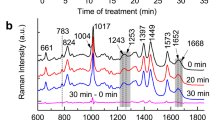Abstract
Although an inhibitory role of the spore matrix on germination of Colletotrichum musae is well established, its role in protecting spores from adverse environmental conditions remains to be proven. The possible role of the spore matrix in the survival of spores of C. musae was investigated by germinating unwashed spores of four isolates after storage at 18°C, washed and unwashed spores of three isolates after storage at -4°C and 37°C, and one isolate after exposure to UV (∼290 nm) radiation. Unwashed spores with the matrix intact consistently survived better than washed spores. The rate of germination of matrix containing stored spores was greater following 1–2 days of rehydration than when immersed directly into water. Removing the matrix was fatal to spores exposed to UV radiation. This study suggests that the spore matrix of gloeosporoid fungi, such as C. musae, is critical to their survival.
Similar content being viewed by others
References
Anthenill FJ, Nicholson RL (1978) Hydrolase activity in the spore matrix of Colletotrichum graminocola: cutinolytic function (Abstr.) Phytopathology Newsletter12, 213.
Bergstrom GC, Nicholson RL (1981) Invertase in the spore matrix of Colletotrichum graminicola. Phytopathologische Zeitschrift102, 139–147.
Bergstrom GC (1978) Role of the conidial matrix of Colletotrichum graminicola (Ces.) Wils. in the corn anthracnose disease. MS Thesis, Purdue University, W. Lafayette, IN.
Chung HS, Wilcoxson RD (1969) Effect of conidial number and matrix on germination of conidia in Phoma medicaginis. Phytopathology59, 440–442.
El-shater ME (1982) Aspects of biology of the rust mycoparasite Darluca filum. PhD Thesis, University of Sheffield.
Griffiths E, Peverett H (1980) Effects of humidity and cirrhus extract on survival of Septoria nodorum spores. Transactions of British MycologicaI Society75, 147–150.
Grover RK (1971) Participation of host exudate chemicals in appressorium formation by Colletotrichum piperatum. In ‘Ecology of leaf surface micro-organism’. (Eds TF Preece, CH Dickinson) pp. 509–518. (Academic Press: London)
Gurvitz A, Rottensteiner H, Hamilton B, Ruis H, Hartig A, Dawes IW, Binder M (1998) Fate and role of peroxisomes during the life cycle of the yeast Saccharomyces cerevisiae — inheritance of peroxisomes during meiosis. Histochemistry and Cell Biology110, 15–26. doi: 10.1007/s004180050260
Lenne JM (1978) Studies on the biology and taxonomy of Colletotrichum species. PhD Thesis, University of Melbourne.
Lingappa BT, Lingappa Y, Bell E (1973) A self-inhibitor of protein synthesis in the conidia of Glomerella cingulata. Archiv fur Mikrobiologie94, 97–107. doi: 10.1007/BF00416685
Louis I, Cooke RC (1985a) Conidial matrix and spore germination in some plant pathogens. Transactions of British Mycological Society84, 661–667.
Louis I, Cooke RC (1985b) Enzymes in conidial matrix of Colletotrichum gloeosporioides and Mycosphaerella pinodes. Transactions of British Mycological Society84, 742–745.
Louis I, Chew A, Lim G (1988) Influence of spore density and extracellular conidial matrix on spore germination in Colletotrichum capsici. Transactions of British Mycological Society91, 694–699.
McRae CF, Stevens GR (1990) Role of conidial matrix of Colletotrichum orbiculare in pathogenesis of Xanthium spinosum. Mycological Research94, 890–896.
Mercer P, Wood RKS, Greenwood AD (1971) Initial infection of Phaseolus vulgaris by Colletotrichum lindemuthianum. In ‘Ecology of leaf-surface micro-organisms’. (Eds TF Preece, CH Dickenson) pp. 381–389. (Academic Press: London)
Mondal AH, Parbery DG (1992) The spore matrix and germination in Colletotrichum musae. Mycological Research96, 592–596.
Nicholson RL, Moraes WBC (1980) Survival of Colletotrichum graminicola: importance of the spore matrix. Phytopathology70, 225–261.
Nicholson RL, Butler LG, Asquith TN (1986) Glycoproteins from Colletotrichum graminicola that bind phenols: implications for survival and virulence of phytopathogenic fungi. Phytopathology76, 1315–1318.
Parbery DG, Blakeman JP (1978) Effect of substances associated with leaf surfaces on appressorium formation by Colletotrichum acuta turn. Transactions of British Mycological Society70, 7–19.
Rambo GW, Bean GA (1970) Survival and growth of the mycoparasite Darlucaftlum. Phytopathology60, 1436–1440.
Singh P (1973) Conidial germination of Colletotrichum falcatum — a study of physiological factors and standardisation of germination technique. Acta Phytopathology Academy Science Hungarian8, 19–41.
Van Burgh P (1950) Some factors affecting appressorium formation and penetrability of Colletotrichum phomoides. Phytopathology40, 29.
Williamson MA, Fokkema NJ (1985) Phylloplane yeasts antagonise penetration from appressoria and subsequent infection of maize leaves by Colletotrichum graminicola. Netherlands Journal of Plant Pathology91, 265–276.
Zhang YY, Brown RW, West CM (1998) Two proteins of Dityostelium spore coat bind to cellulose in vitro. Biochemistry37, 10766–10779. doi: 10.1021/bi9808013
Author information
Authors and Affiliations
Corresponding author
Rights and permissions
About this article
Cite this article
Mondal, A.H., Parbery, D.G. The protective role of the spore matrix of Colletotrichum musae during rehydration and exposure to extreme temperatures and UV radiation. Australasian Plant Pathology 34, 229–235 (2005). https://doi.org/10.1071/AP05030
Received:
Accepted:
Published:
Issue Date:
DOI: https://doi.org/10.1071/AP05030




